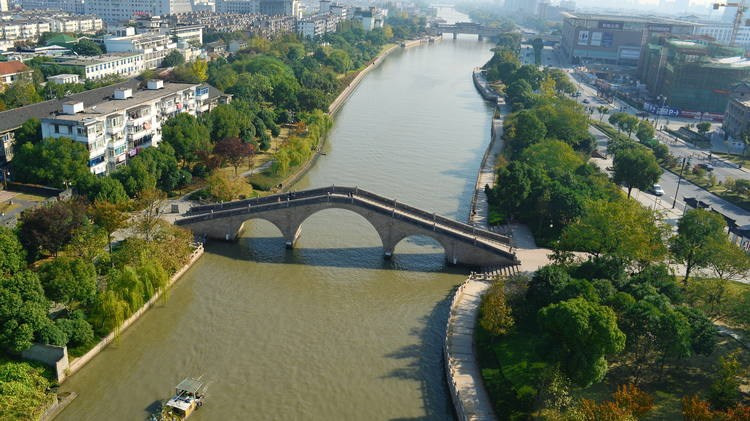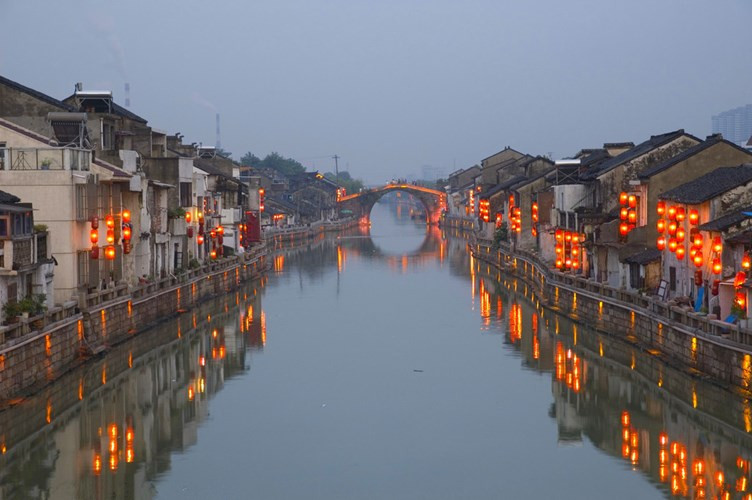Explore the most magnificent canal in the ancient world
During the peak period, Dai Van Ha canal had a total length of 2,500 km. So far, the canal still plays a big role in water transport.
Having a history dating back to the 5th century BC, China 's Dai Yun Ha Canal (King of the Great Way) is an ancient canal of the greatest scale in the world. This canal is now about 1,800 km long, flowing through many cities and provinces of China, including Beijing, Tianjin, Hebei, Shandong, Jiangsu and Zhejiang.
The history of Dai Van Ha began at the end of the Spring and Autumn Period (722-481 BC), when Ngo Vuong Phu Sai, the king of Ngo country brought troops to the north to conquer other kingdoms. He ordered the canal to transport soldiers, this channel is called Han Qiao.

China 's Great Waterway Canal (King of the Great Way) is the ancient canal of the greatest scale in the world.
The first section of the canal is located near Yangzhou, Jiangsu to carry water from the Yangtze River to the north connecting the Huai River. According to a passage in a book by Confucius, it was built around 486 BC. This is the oldest part of this canal. This passage has been repaired and expanded in the 3rd century.
The Dai Van Ha channel was extended to the Sui Dynasty (581-618). In 604, Sui De De of the Sui Dynasty left Truong An (now in Xi'an) to transfer the capital to Luoyang. In 605, the emperor entrusted the expansion, extending Dai Yun Ha to Vu Van Khai, to connect Trac District (now Beijing) to Hangzhou.

This canal has a length of up to 1800km.
This work lasted for 6 years to link 5 river systems to Dai Van Ha. When completed, it connects the rivers of Hai Ha, Hoang Ha, River Hoai, Tien Duong and Truong Giang. The total length of this canal system at that time was about 2,500km. It was used to transport troops for the Sui - Cao Ly war.
During the Tang Dynasty (618-907), Dai Yun Ha was the main way to transport grain from the Changjiang Delta region to the North China. Khai Phong City was the main transfer station on this waterway, and so it grew gradually to become the capital of Song Dynasty (960-1279).

The Dai Van Ha channel was repaired and rebuilt by Minh Thanh To in the years 1411-1415.
During the Yuan Dynasty (1271-1368), the Chinese capital moved to Dai Do (Beijing) and thus the demand for the Great Ha River to the west to Khai Phong and Lac Duong was greatly reduced. The canal was later diverted to a shortcut in Shandong Province during the years 1280 to 1283. The total length was then around 1,800km and has not changed much so far.
The entire canal was renovated and rebuilt by Emperor Minh Thanh To between 1411 and 1415. Within the next 400 years, it was maintained quite well as the main artery for transport. food from the Yangtze River basin to Beijing.

This canal is the main artery to transport food from the Yangtze River basin to Beijing.
In 1855, the Yellow River caused flooding and changed currents towards Shandong, cutting off the route of Dai Yun. Due to the difficulties to cross the mudflats of the Yellow River, along with the development of shipping, as well as the introduction of railway lines, the northern and southern parts of the canal was not connected anymore. This greatly reduced the role of the canal. Many parts of it have not been remodeled and some sections are blocked by mud. After the government of the People's Republic of China was born in 1949, in response to the need for economic development, the government had to carry out the reconstruction of the Great Transport.

Dai Van Ha Canal has been recognized by UNESCO as a World Cultural Heritage in 2014.
Today, the central and southern sections of Dai Van Ha are well maintained and are used heavily to transport coal from coal mines in Shandong province and northern Jiangsu province to the river delta region. Yangtze. With great historical values, in 2014 Dai Van Ha Canal was recognized by UNESCO as a World Cultural Heritage.
- Admire the 16 most magnificent ancient trees in the world
- Admire the most magnificent city ruins of ancient times
- Incredible set of Panama Canal construction
- Unprecedented discovery: People know how to treat root canal from the 8th century
- Admire the 10 most magnificent palaces in the world
- Suez Canal - Great dream of kings
- Ships set records when passing through narrow canals
- Europe's Canal du Center - World Cultural Heritage in Belgium
- Discovery of the canal
- Explore the magnificent Royal Palace of Japan
- The 1,500km water canal crafted by the steep cliff side
- Venice and canal system
 'Fine laughs' - Scary and painful torture in ancient times
'Fine laughs' - Scary and painful torture in ancient times The sequence of numbers 142857 of the Egyptian pyramids is known as the strangest number in the world - Why?
The sequence of numbers 142857 of the Egyptian pyramids is known as the strangest number in the world - Why? History of the iron
History of the iron What is alum?
What is alum?